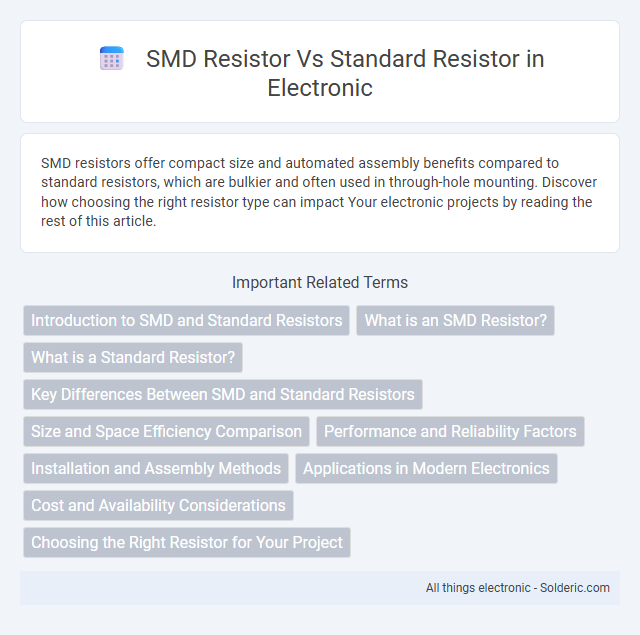SMD resistors offer compact size and automated assembly benefits compared to standard resistors, which are bulkier and often used in through-hole mounting. Discover how choosing the right resistor type can impact Your electronic projects by reading the rest of this article.
Comparison Table
| Feature | SMD Resistor | Standard Resistor |
|---|---|---|
| Mounting Type | Surface Mount Device (SMD) | Through-Hole Mount |
| Size | Compact, typically 1mm to 6mm | Larger, varies from a few mm to several cm |
| Power Rating | Lower, usually 0.063W to 0.5W | Higher, commonly 0.25W to 5W or more |
| Installation | Automated pick-and-place machines | Manual or automated insertion and soldering |
| Performance | Precision and low parasitic inductance | Robust, better heat dissipation |
| Applications | Compact electronic devices, high-density PCBs | Power electronics, prototypes, and test circuits |
| Cost | Generally lower per unit in mass production | Higher per unit, easier for manual assembly |
Introduction to SMD and Standard Resistors
SMD resistors, or Surface-Mount Device resistors, are compact components designed for automated assembly on printed circuit boards (PCBs), offering high precision and space-saving advantages compared to standard resistors. Standard resistors, also known as through-hole resistors, feature leads for insertion into PCB holes, providing robust mechanical strength and ease of prototyping. Both types serve critical roles in circuit design, with SMD resistors favored in modern electronics for miniaturization and higher frequency performance.
What is an SMD Resistor?
An SMD resistor, or Surface-Mount Device resistor, is a compact electronic component designed for mounting directly onto the surface of printed circuit boards (PCBs), enabling high-density circuit designs. Unlike standard through-hole resistors, SMD resistors offer smaller sizes and improved performance in high-frequency applications due to reduced lead inductance. These resistors are commonly used in modern electronics for their efficiency in automated assembly and space-saving capabilities.
What is a Standard Resistor?
A standard resistor, also known as a through-hole resistor, is a passive electronic component designed to limit electrical current flowing through a circuit by providing a fixed resistance value. These resistors feature wire leads that allow them to be inserted into holes on a printed circuit board (PCB) and soldered for secure electrical connection. Standard resistors are typically larger than surface-mount device (SMD) resistors and are often used in applications requiring higher power dissipation or easier manual assembly and replacement.
Key Differences Between SMD and Standard Resistors
SMD resistors are surface-mounted components characterized by compact size and higher packing density, ideal for automated assembly processes, whereas standard resistors, often through-hole types, are larger and suited for manual placement and prototyping. SMD resistors typically exhibit lower parasitic inductance and capacitance, enhancing performance in high-frequency applications compared to standard resistors. Resistance tolerance options and power dissipation ratings differ, with standard resistors generally offering higher wattage capabilities but less space efficiency than SMD counterparts.
Size and Space Efficiency Comparison
SMD resistors are significantly smaller than standard through-hole resistors, often measuring just a few millimeters, which enables high-density circuit designs and better space utilization on PCBs. Their compact size reduces parasitic inductance and capacitance, enhancing performance in high-frequency applications compared to larger, bulkier standard resistors. SMD components streamline automated assembly processes, allowing manufacturers to design smaller, lighter, and more efficient electronic devices.
Performance and Reliability Factors
SMD resistors offer superior performance with lower parasitic inductance and capacitance compared to standard through-hole resistors, making them ideal for high-frequency applications. Their compact size enhances heat dissipation, contributing to greater reliability under thermal stress. You benefit from improved circuit stability and longevity when choosing SMD resistors in precision electronic designs.
Installation and Assembly Methods
SMD resistors are designed for surface-mount technology (SMT), allowing automated pick-and-place machines to rapidly position them onto PCB pads, resulting in higher assembly precision and faster production cycles. Standard resistors rely on through-hole mounting, which requires manual insertion or wave soldering, making the assembly process slower and less suitable for high-volume manufacturing. The SMT approach with SMD resistors reduces PCB space and improves electrical performance by minimizing lead inductance compared to through-hole resistor installations.
Applications in Modern Electronics
SMD resistors are extensively used in modern electronics due to their compact size, enabling high-density circuit designs in smartphones, laptops, and wearable devices. Standard resistors, with larger sizes and through-hole leads, are preferred in prototyping, educational projects, and applications where manual soldering and heat dissipation are critical. Your choice between SMD and standard resistors impacts assembly efficiency, circuit reliability, and device miniaturization capabilities.
Cost and Availability Considerations
SMD resistors generally offer lower costs due to automated mass production and smaller material usage, making them more economical for high-volume electronic manufacturing. Standard through-hole resistors might be more readily available in specialized values and higher wattage ratings, catering to prototyping and repair needs. Your choice depends on balancing cost-effectiveness with the availability of specific resistor types suited to your application requirements.
Choosing the Right Resistor for Your Project
SMD resistors offer compact size and high efficiency, making them ideal for modern electronics requiring space-saving components, while standard resistors provide robustness and easier handling for prototyping and low-frequency applications. Consider power rating, tolerance, and mounting method when selecting the right resistor, as SMD types excel in high-density PCB layouts and automated assembly, whereas standard resistors suit larger, low-volume builds. Balancing electrical specifications with physical constraints ensures optimal performance and reliability in your project design.
SMD resistor vs standard resistor Infographic

 solderic.com
solderic.com